10 new uses for vintage wool blankets
Wool blankets are one of the main items I look for at garage sales, thrift stores, and antique stores. Textiles are usually pretty inexpensive when you find them used. Wool blankets might have a high price tag, even at a thrift store if they are considered collectible. Hudson Bay blankets with their heavy fulled character and stripes are usually at the high end, along with Pendleton blankets. Most other 100% wool blankets will be very inexpensive in the $3 to $15 range, depending on their condition and size. But I buy even the higher-priced Hudson’s Bay blankets when I can find them, because of their warmth and durability. The most I’ve paid is $29 for a full size, Emerald Green, heavyweight, Hudson’s Bay Point Blanket that had a few small moth holes but was otherwise in good condition. The least I’ve paid is $5 for a natural beige, medium weight, wool blanket from a Scottish woolen mill. Garage sale prices are usually less than thrift store prices. If you find a Hudson’s Bay Point blanket and would like to find out more about its provenance, check here.
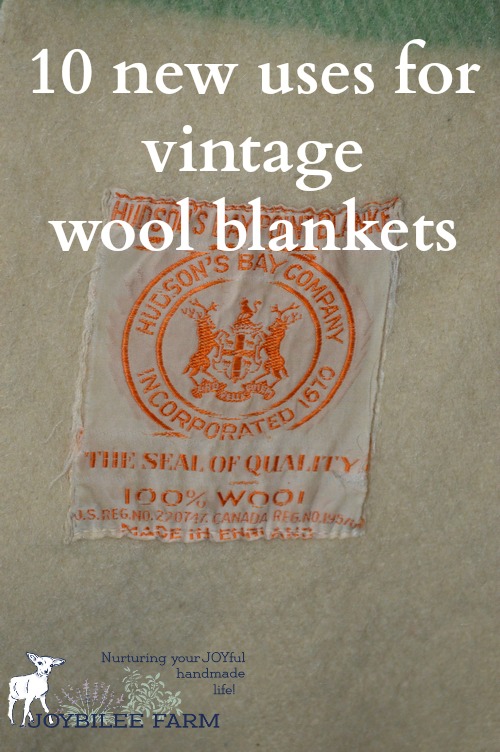
Advantages of wool blankets over synthetics
Wool has some very valuable characteristics that can help you in winter:
- It is insulating even when wet.
- It is naturally flame resistant
- It is soil and stain resistant
- It is naturally antibacterial
- Wool is breathable
- Wool is nontoxic
- Wool wicks moisture away from your skin
- It grows on sheep so it’s a renewable fiber
- It composts naturally
- It is washable
- It can be stored until you need it
- It is durable and will last for many, many years
- When it wears out it can be repurposed through several evolutions before it’s no longer useful.
What to look for when you purchase thrift store wool blankets
The most common issue with thrift store wool blankets is moth holes. Look over the blanket thoroughly for holes. Even hold it up to the light to see. Often these don’t show up until you wash it but when you hold it up to the light you’ll see thin areas that will wash away. A few small holes aren’t reasoning enough to reject a blanket but it could be evidence that there are live larvae or eggs in the blanket. If you decide to purchase it in spite of the moth holes be sure to wash it in hot water as soon as you get it home. Small moth holes can be repaired. Large areas of damage will need to be patched to prevent further damage.
Blankets that have been stored in the attic or the basement may have mold or mildew. If the blanket smells musty or you can see visible black spots, these probably won’t wash out. The musty smell may also be permanent. I generally won’t bring a musty blanket home.
Strong odours like mothballs or smoke can be problematic as well. These generally need several washings to clean out of wool blankets. Weigh the price against the extra work to make them useable.
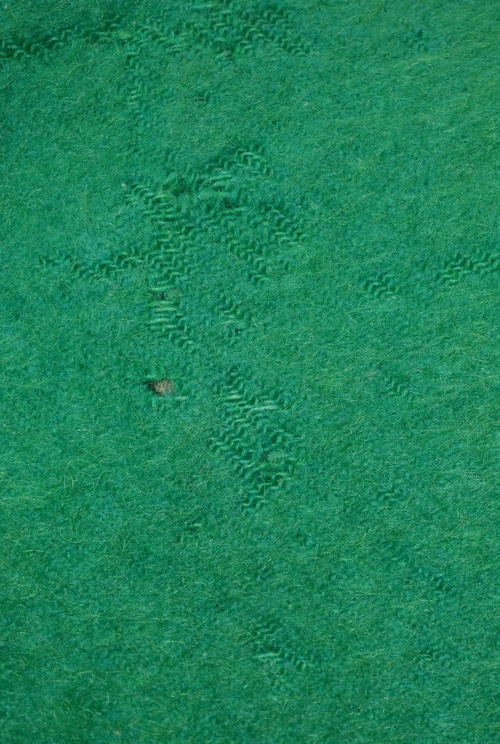
Moth damage on a Hudson’s Bay Point Blanket
How to wash a wool blanket
Plan to wash any wool blankets as soon as you get them home. I wash mine using a special technique that I reserve for wool garments. I have a top-loading older Maytag washing machine that doesn’t let the water run into the machine during the spin cycle. If your machine doesn’t have this feature, you’ll want to turn off the water once your machine is filled up.
I fill my washing machine with hot water. Add a squirt of Joy dish soap once it is full. I put in one to three wool blankets, depending on how heavy they are. I let the wool blankets sit in the washing machine, without agitating for 1 hour. Then I turn the dial to the spin cycle and spin the excess water out of the blankets. I then remove the blankets from the machine and refill them with the same temperature water. Add the wool blankets back in and let them sit in the clear, hot water for an additional 30 minutes. Then I turn the dial to the spin cycle and spin the excess water out of the blankets. If the blankets are especially musty smelling I will repeat this step once more. Then I hang them out on the line in full sun, to dry. If it’s winter, I’ll hang them over clothes racks by the wood store. Try to dry them completely within 48 hours.
Generally, I wash my wool blankets every spring, after a winter of use, before storing them for the summer. I will also wash them if they become soiled from using them in the car or outside.
What about bed bugs?
If you have a concern about bed bugs in your region, after washing your wool blanket in hot water, and air drying it, do one more step to ensure that there is no contamination. Iron the wool blanket with a hot iron set on the wool setting. Be sure to iron every inch of the blanket and overlap your strokes. It is alright to steam wool blankets, once they are thoroughly dry. The heat will kill any eggs or larvae of any pests that may still be in the threads of the blanket.
Protect Wool Blankets from Wool Moths
One drawback of using wool blankets is that they should be protected from wool moths and pantry moths. The nitrogen in wool attracts moths. They lay their eggs in wool and the larvae eat holes in the wool before they spin their cocoons. You can protect your wool blanket investment by always storing your blankets clean. Wash them after the winter, and store them in a cedar chest, like grandma used to. Or hang aromatic cedar blocks in your blanket closet. Alternatively, sachets with tea tree, peppermint, and lavender essential oils will repel wool moths. Check your closet at least once a month during the summer and vacuum well, if you find any evidence of moths. I find that July and August are the most critical times and if I can win the battle there, I’m good for the year. Wool blankets that are used regularly are not as prone to moth damage.
10 uses for Wool Blankets
1. Use a wool blanket under the fitted bed sheet
Wool is insulating. Just by adding a wool blanket under the bottom sheet, you’ll create a warmer bed. Wool is warm in winter, but won’t increase the heat in summer. Just place the wool blanket over your mattress pad but under your fitted bottom sheet.
2. Cover a window in wool
Wool on the window will cut down on drafts – keeping the warm air in the room and the cold air outside. But since it’s a natural fiber, it still allows air exchange so you won’t have the condensation problems that plastics contribute. I add a wool blanket to the windows in our unheated bedrooms in winter, fastening them with clothes pegs to the curtain rod. In summer I take them down and store them.
3. Keep a wool blanket on the couch
When it’s cold and the woodstove just isn’t keeping the room warm, cuddling in a wool blanket can make the difference between whiney kids and contented kids. Better yet, cuddle with someone else under a wool blanket and you’ll both be more content.
4. Keep a wool blanket at the foot of the bed for cccold nights
Sometimes you need just a little extra warmth. Or if you are a woman of a certain age, you may not but your partner might. Wool blankets are the perfect solution. You can add a wool blanket just on the side where the extra warmth is needed without cooking out the person who experiences summer in winter, on occasion. We have two heavy Hudson Bay blankets on our bed, one for each of us, because we no longer have the same internal thermostat. Most nights I don’t need an extra blanket, but when it’s -30C, and you’re heating with wood, the extra insulation of a wool blanket can be a lifesaver.
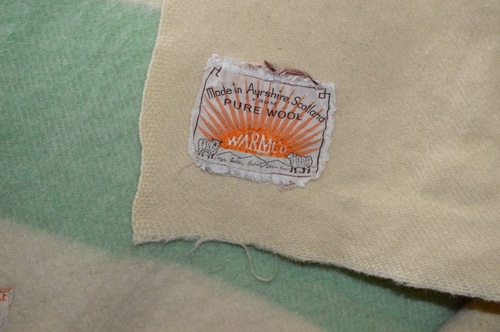
5. Keep a wool blanket in the car
On long car trips, a wool blanket can be cozy. In an emergency, it can save a life. Don’t keep your best blanket in the car, though, as the blanket in the car gets soiled more often than the ones in your house. On long trips, I pack a wool blanket for each person in the vehicle. We’ve used them in hotels when the hotel didn’t provide enough blankets. We’ve used them to keep warm on cold mornings while waiting for the vehicle heater to warm up the car. We’ve used them as a pillow to take a nap on the drive.
6. Take them with you to cushion furniture or windows when transporting
We bought windows for the writers’ retreat last summer, and when we picked them up I took 10 wool blankets to place between the windows and to keep them from damage on the long trip over the mountain to take them home. Wool is soft and won’t scratch fine furniture, and it’s resilient, cushioning the shock of transport.
7. Use wool blankets as a bedroll or sleeping bag
A full-size wool blanket is lightweight and can be used as a sleeping bag. Simply lay on it diagonally and pull the bottom corner over your feet. Take the left side and pull it loosely over your body, and then take the right side and pull that loosely over your body, the other way. Tuck the corner under you to secure the end. You’ll have 2 layers of wool over your body and one under it, keeping it warm.
Check out this video from Forrester Bushcraft to see this technique demonstrated.
8. Turn a wool blanket into a chair
This is genius. Check out this video and see how Black Owl Outdoors folds and ties a wool blanket into a useful camp chair.
9. Turn a wool blanket into a coat
The Hudson Bay Company occasionally has workshops where Hudsons Bay Blankets are sewn into classic coats. Here is a layout pattern to make a Capote coat from a Hudson’s Bay blanket.
Here’s a way to make a wool coat from a blanket without cutting the blanket.
10. Fold a wool blanket and use it as a chair cushion
Sitting for long periods in a cold house can be uncomfortable. Just adding a folded wool blanket to the seat of a chair can improve the seating comfort. Wool is breathable and comfortable, as well as insulating.
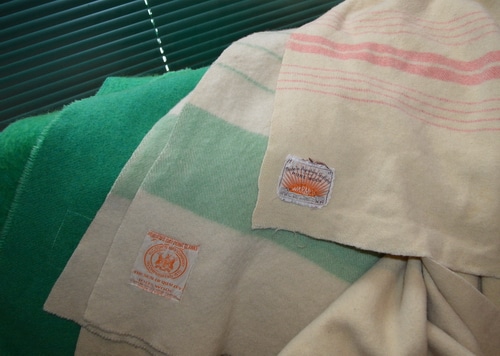
What’s the best blanket find you’ve made? What did you do with it after you brought it home?


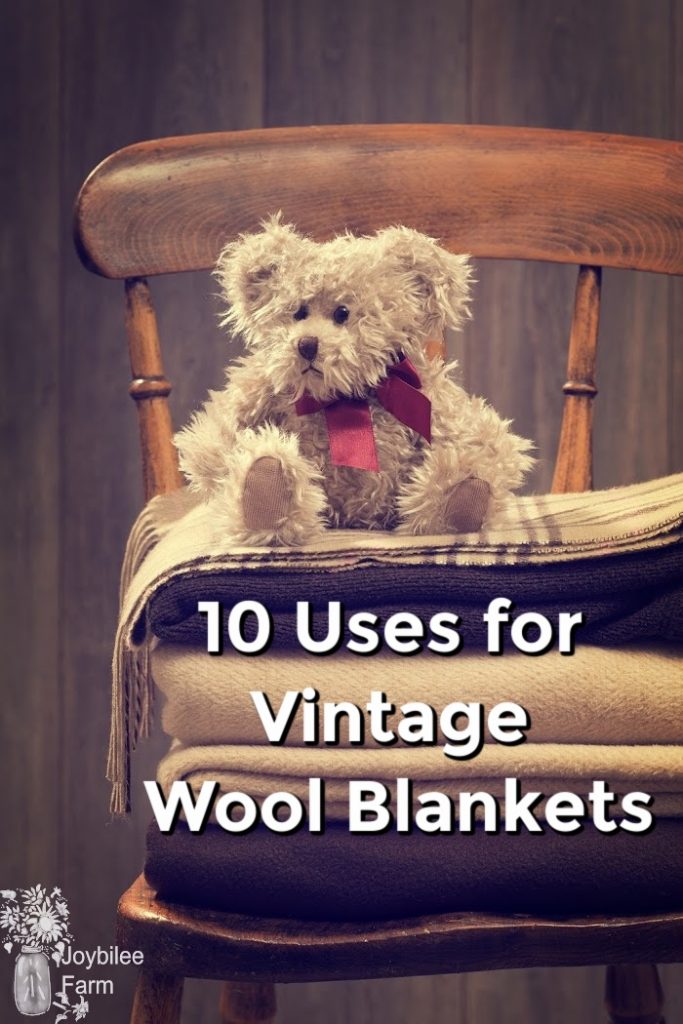

That is a great idea. I’m working on a post about waterproof camping blankets (https://campingcrossroads.com/waterproof-outdoor-blankets/) and I wanted to incorporate some vintage wool blankets but wondering what the best method would be to use a wool blanket as the insulation with a more waterproof material sewn on the outside to provide more protection from rain and wet weather.
Yes, I bought a Hudson Bay blanket in very good shape but the label was falling apart. I finally removed the crumbling label.
I have joined many pieces of wool blankets together using a stitch on my sewing machine.
I butt the two pieces together FLAT and sew – this stitch is a zig zag with stitches on both edges. My machine is a Janome. After I iron the seams with a wool setting.
FABULOUS!!!
I am planning to remove the satin and trim the blankets with print Liberty if London seam binding..
I have 2 Whitney blankets and would like to join them to make a king size blanket. I would like advice on how to do the seams